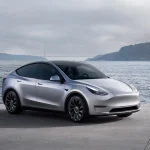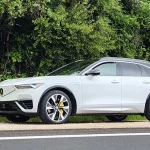
Nepal was once an electric-vehicle leader. What happened?Nepal was once an electric-vehicle leader. What happened?
With California and its electric-vehicle mandate under threat as the federal government takes aim at the state’s greenhouse gas emissions authority, it pays to remember how much power governments can wield in how quickly we go electric.
While China and Europe have provided significant encouragement for electric vehicles, there are a few lesser-known markets in which electric vehicles have been encouraged and then suddenly disincentivized.
Kathmandu is one of those. As a CityLab piece from last month underscores, it was once on its way toward becoming an exemplar of fully electric mass transit—long before the significant moves toward electric-bus adoption of the past several years elsewhere in the world.
“Tesla showed the world that electric vehicles were the future,” said Ramesh Parajuli, an academic and environmental activist to CityLab. “But in a way, we had already done that.”
In short, by the 1990s Kathmandu knew that it was facing a crisis point with air pollution. To replace one of vehicles most blamed for the issues—a fleet fo 640 Indian diesel-powered 12-passenger buses called Vikram Tempos was largely replaced by the Safa Tempo, a version concocted by a U.S. NGO and powered by lead-acid golf-cart batteries.
Safa Tempo
That technology was purchased by Nepal Electric Vehicles Industries (NEVI), and its founder Bijay Man Sherchan announced plans to reinvent Kathmandu as the “Shangri-la for electric vehicles.”
At one time the modest fleet (still more likely to be driven by women) supported emissions-free trips for 100,000 people every day, and there were 38 charging stations in place to support the vehicles.
Running costs weren’t all that impressive; the set of batteries cost $1,720 and had to be replaced about every two years. But it was ultimately not that but politics that doomed the mission. As the number of Tempos peaked in 2000, a tariff exemption for owners of the old Vikrams ended the era, as they rushed to replaced their vehicles with 15-passenger Toyota microbuses.
Although a number of Safa Tempos remain in service, advocates for the EV couldn’t get past entrenched transit operators. Meanwhile the pollution becomes worse, and the number of vehicles in the city has gone from 100,000 in 2000 to 1.17 million this year. And now, Nepal actually has an electricity surplus due to an abundance of hydropower, and modern lithium-ion batteries offer far better range, performance, and longevity.
Kathmandu announced last year to replace its gasoline buses and microbuses with electric ones by 2030 with a commitment of funds in 2019 to buy 30 vehicles. And the Nepal government now has a “National Action Plan for Electric Mobility,”
At this time, however, Nepal has to rely on EVs from China and India, and some can’t help but wonder how much better the air in Kathmandu might have been had the government backed a transition to electric that was already on its way.
The technology riptide might be impossible to ignore now, yet California still potentially has a lot to lose as a trend-setter for going tailpipe-free.
[h/t John Voelcker]
View original article at: “https://www.greencarreports.com//news/1125158_nepal-was-once-an-electric-vehicle-leader-what-happened”
Add a comment Cancel reply
Comments (0)
ที่พักเชียงคาน
… [Trackback]
[…] Read More on to that Topic: autoseu.com/nepal-was-once-an-electric-vehicle-leader-what-happenednepal-was-once-an-electric-vehicle-leader-what-happened/ […]
jarisakti
… [Trackback]
[…] Find More Information here on that Topic: autoseu.com/nepal-was-once-an-electric-vehicle-leader-what-happenednepal-was-once-an-electric-vehicle-leader-what-happened/ […]
LSM99LIVE เว็บตรงของแท้ อันดับ 1
… [Trackback]
[…] Read More on that Topic: autoseu.com/nepal-was-once-an-electric-vehicle-leader-what-happenednepal-was-once-an-electric-vehicle-leader-what-happened/ […]
Fryd
… [Trackback]
[…] Information on that Topic: autoseu.com/nepal-was-once-an-electric-vehicle-leader-what-happenednepal-was-once-an-electric-vehicle-leader-what-happened/ […]
Categories
- Activism (1)
- Adventure (1)
- Advertising (2)
- Agriculture (1)
- Air pollution (4)
- Air transport (3)
- aluminium (2)
- Amazon (3)
- Animals (1)
- Apple (2)
- Architecture (1)
- Arctic (1)
- Artificial intelligence (1)
- Augmented Reality (1)
- Auto Detailing (1)
- autopilot (1)
- battery (31)
- Best summer holiday destinations 2022 (1)
- Bicycle (1)
- biodiversity (1)
- BMW (2)
- boat (1)
- Bus (1)
- Business (4)
- Buying Guides (1)
- car (7)
- Car industry (18)
- Car News (18)
- car rental (3)
- Car Reviews (4)
- Car sales (6)
- carbon emissions (15)
- carbon footprint (3)
- Carlos Ghosn (1)
- Cars (66)
- Central Europe (1)
- CES (2)
- charging station (11)
- Children (1)
- China (12)
- Citroën (1)
- city (1)
- City transport network (2)
- clean energy (2)
- Climate (1)
- climate change (9)
- Climate crisis (4)
- Climate emergency (2)
- climate protection (2)
- CO2 emissions (39)
- Company (3)
- Competition (1)
- Conscious travel (2)
- Contamination of water (1)
- Copper (2)
- cost of living (2)
- Cuba (1)
- Cuban politics (1)
- Cybertruck (1)
- Cycling (1)
- deforestation (1)
- delivery (3)
- Denmark (2)
- Detroit (1)
- Diesel (4)
- Diesel car (7)
- e-mobility (11)
- e-scooter (2)
- Eco travel (3)
- Eco-friendly (2)
- Ecology (1)
- Economy (1)
- El Niño (1)
- Electric (11,302)
- Electric boats (1)
- electric car (107)
- Electric Cars (499)
- Electricity (5)
- Electricity consumption (3)
- Electricity market (5)
- Elon Musk (21)
- emission (1)
- Emmanuel Macron (1)
- Energy (2)
- Energy low cost (1)
- energy transition (6)
- Entrepreneur (1)
- Environment (5)
- Environment pollution (1)
- Environmental protection (4)
- EU Policy (1)
- EU-China (2)
- Europe (7)
- Europe's energy crisis (1)
- European Commission (3)
- European economy (2)
- European Union (18)
- Euroviews (6)
- Eviction (1)
- EVs (37)
- F1 (1)
- factory (4)
- fake news (1)
- family (2)
- Ferrari (1)
- fertilizer (1)
- fine (penalty) (1)
- fire station service (1)
- flight (1)
- Flying car (4)
- Food security (1)
- Ford (1)
- Formula 1 (2)
- Fossil fuels (14)
- France (39)
- free trade (1)
- Fuel (3)
- Fuel cell electric vehicles FCEV (10)
- fuel crisis (2)
- Fuel Efficiency (3)
- fuel prices (1)
- Funeral (1)
- Gas (1)
- Gas Prices (1)
- gasoline price hike (1)
- German (1)
- Germany (8)
- Giorgia Meloni (1)
- Global warming and climate change (1)
- Good News (1)
- Greece (1)
- green energy (1)
- green new deal (1)
- Green transportation (17)
- Green Week (1)
- greenhouse gas emissions (6)
- Hanoi (19)
- Health (1)
- home (2)
- homelessness (1)
- Housing market (19)
- human rights abuse (1)
- Hybrid (2,283)
- Hybrids (116)
- Hydrogen (2)
- hydrogen vehicle (2)
- IAA Mobility (2)
- Iceland (3)
- incident (1)
- income (1)
- India (2)
- Indonesia (1)
- infrastructure (1)
- innovation (1)
- International relations (1)
- Investment (4)
- iPhone (1)
- Japan (1)
- Jobs (3)
- Joe Biden (4)
- Jubilee (1)
- Lampedusa (1)
- Las Vegas (1)
- lead petrol (2)
- Lithium (13)
- liveable cities (2)
- London (3)
- Luxembourg (1)
- Luxury (2)
- luxury goods (2)
- Luxury lifestyle (2)
- Manufacturing (5)
- Market (1)
- Markets (1)
- meat (1)
- Mercedes-Benz (39)
- Migrants (1)
- minerals (2)
- Mining (5)
- Mitsubishi Motors (1)
- Mobile World Congress (1)
- Mobility (10)
- Mobility Week (2)
- Mobility Week 2021 (1)
- Mobility Week 2023 (5)
- money (3)
- Motorcycling (2)
- Motorsport (1)
- Mountain (1)
- NASA (1)
- nature (2)
- net-zero (2)
- New technologies (6)
- Next Explainers (1)
- Next In data (2)
- Nigeria (1)
- Nissan (3)
- Norway (7)
- Nuclear Energy (1)
- nuclear fusion (1)
- Nuclear power plant (1)
- Odd (1)
- oil industry (1)
- Olaf Scholz (1)
- online shopping (1)
- Oslo (1)
- Paris (1)
- parody (1)
- Petroleum products (3)
- Peugeot (1)
- plastic (1)
- Poland (1)
- Politics (1)
- Pollution (44)
- Power Plant (1)
- prices (1)
- production (1)
- Profits (1)
- Prostitution (1)
- Public transport (4)
- Racing cars (1)
- Racism (1)
- Rail transport (2)
- rats (1)
- Raw material (1)
- Recycling (4)
- Renault (3)
- Renewable energies (6)
- renewable energy (6)
- Reykjavík (1)
- Rishi Sunak (1)
- road (36)
- Road infrastructures (1)
- Road safety (7)
- Road transport (20)
- road trip (1)
- Robot (1)
- Rolls Royce (1)
- Russia (1)
- Russia's invasion of Ukraine (2)
- Sadiq Khan (1)
- safari (1)
- Safety (1)
- Sale (1)
- sales (3)
- Scotland (1)
- self-driving (43)
- Semiconductor (1)
- Shares (1)
- Show (1)
- Silicone (1)
- Software (1)
- Solar energy (2)
- solar power (5)
- Space technology (1)
- Spain (1)
- start-up (3)
- Stock exchange transaction (1)
- Stock market activity (1)
- Stockholm (1)
- Strasbourg (1)
- Students (1)
- Summer Olympics (2)
- Sustainability (7)
- Sustainable city (3)
- Sustainable design (3)
- Sustainable development (1)
- Sustainable innovation (9)
- Sustainable technology (21)
- Sustainable tourism (4)
- Sweden (2)
- Tata Motors (2)
- Tax (37)
- Taxes (2)
- Taxi (1)
- Technology (55)
- Tesla (73)
- The Boring company (1)
- Tokyo Olympic Games 2020 (1)
- Toyota (4)
- trade (3)
- traffic (1)
- Trains (2)
- Transport (11)
- transportation (3)
- Travel destinations (1)
- Tunnel (1)
- Twitter (3)
- UBER (1)
- Ukraine war (1)
- Uncategorized (6)
- United Kingdom (5)
- United States (6)
- urban planning (2)
- Ursula von der Leyen (3)
- US politics (1)
- USA (1)
- vegan (1)
- vehicle (7)
- Video (4)
- Vietnam (19)
- Volkswagen (3)
- Volvo (2)
- waste (1)
- waste disposal (1)
- Water (1)
- Water resources (1)
- White House (1)
- wind energy (1)
- Wind turbine (1)
- Winter (2)
- work conditions (1)
- World Travel Market (1)
- Xiaomi (1)
Recent Posts
About us

Popular Tags
Related posts


Volvo EX30 in the test: Really a premium car at a volume price?

VW ID.7: Estate is not called Variant... It's a Tourer







